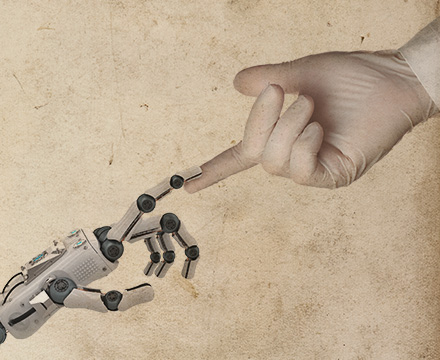Six Robots Helping Doctors Today
Six Robots Helping Doctors Today


Driven by the needs of surgeons to improve patient outcomes and reduce healthcare costs, as well as the rapid advances in sensor and artificial intelligence technologies, robot manufacturers are developing medical robots with improved functionality for a variety of uses, including minimally invasive surgeries.
Robotic systems already provide a wide range of services in healthcare, including surgical assistance, patient rehabilitation, cleaning and sterilization, dispensing drugs, and remote diagnosis. We can expect many more of the soon. The global medical robots market is expected to reach $16.74 billion by 2023, up from about $6.46 billion in 2018—representing a compound annual growth rate of 21 percent, according to the research firm Markets and Markets.
ASME TechCast podcast: Breakthrough Could Bring New Cancer Treatment
Below are six innovative robot healthcare applications that improve patient outcomes and reduce the stress load on busy healthcare practitioners.
1. Senior care
An increasing number of hospitals and facilities use robots to assist with patient care and treatment. Mobile robots assist with transport tasks or guide people to their destinations. Personalized, pet-like robots such as “Paro” help alleviate loneliness and create a sense of purpose. Companion robots use AI algorithms that allow them to react to behavior patterns and proactively engage with patients and residents.
2. Exoskeletons
Exoskeletons are robotic devices that range from prosthetic body parts to full suits that help paralyzed people walk. ReWalk, for example, is a wearable robotic exoskeleton that is strapped to the body and provides powered hip and knee motion that enables individuals with severe spinal cord injuries to walk upright, turn, and even climb and descend stairs. It may also be possible that exoskeletons can help restore normal motor function by retraining the damaged nervous system itself.
Top Story: VR and Drone Technology in a Paper Airplane
Veebot Systems has created a robot that can draw a blood sample in about one minute. The technology combines medical imaging, computer vision, and machine learning to identify the best target insertion site, determine depth to the target underneath the skin, and insert the needle. Veebot identifies the best target vein nearly 85 percent of the time—about the same as an experienced human phlebotomist.
4. Colonoscopy
Although colonoscopies are considered routine procedures, they are often uncomfortable and can result in serious side effects and even death if the intestinal wall is punctured. Researchers at Vanderbilt University have developed a robotic system that can conduct a standard colonoscopy procedure with fewer side effects. An electronic capsule robot examines the colon internally, guided by magnets outside the body. The capsule robot can also perform biopsies, polyp removal and retrieve tissue samples.
5. Bone surgery
Developed by AOT AG, the CARLO (Cold Ablation Robot-guided Laser Osteotome) is a robot arm that performs laser bone ablation—the surgical removal of a section of diseased bone. Using advanced navigation and control software, the device allows surgeons to perform bone operations with unprecedented precision and in freely defined, curved and functional sectional configurations, which cannot be done with conventional instruments.
6. Nanobots
Researchers are hard at work developing cell-sized robots that can flow through the bloodstream and carry out life-saving tasks such as attacking cancer cells with payloads of cancer-killing drugs, removing blockages from arteries, or performing tissue biopsies. These microscale or nanoscale robots are far less likely to cause large-scale side effects that often result from conventional medical treatments like chemotherapy.
Recent successes in this field include autonomous microrobots propelled by hydrogen microbubbles that have treated gastric bacterial infections in mice. Last year, scientists from the National Center for Nanoscience and Technology (NCNT) in China and Arizona State University developed microrobots only a few hundred nanometers across that, when injected into mice, shrunk their tumors by cutting off their blood supply.
Editor’s Pick: Five Steps from Engineer to Leadership
Guangjun Nie, a NCNT member of the research team, pointed out these robots sense their environment, navigate, and carry out mechanical tasks—just like large robots.
“Nanorobots are the next generation of nanomedicines because they give us much better control and can be made to work like a machine,” Nie said. "In the future, we will demonstrate even more scenarios for our nanorobots, from monitoring disease to finding tissue damage, curing cancer, and maybe even finding and destroying plaques in our blood vessels."
Mark Crawford is an independent writer.
Read Latest Exclusive Stories from ASME.org: Lighter Axle Reinvents Drivetrain. Does Detroit Care? Engineers Making Waves in Aquaculture Solving World Hunger with 3D-Printed Food





